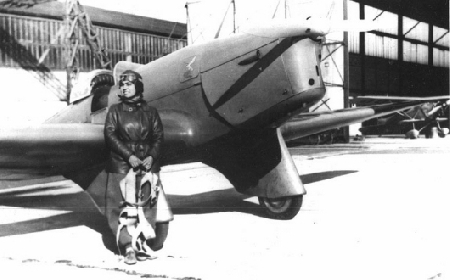The first Romanian woman pilot and skydiver
Smaranda Braescu was the first woman pilot, skydiver and instructor of army pilots in Romania.

Steliu Lambru, 18.02.2013, 11:43
Aeronautics was a very popular domain in Romania between 1920- 1940. It was a period of effervescent emulation for those young people who had a passion for aeronautics and who were attending flight clubs and schools, programs, and trainings and who were also participating in contests. Some of them scored great successes in competitions that pitted them against pilots from countries with a long-standing tradition in the field. One of Romania’s greatest pilots and skydivers was a woman, Smaranda Braescu. She was actually the first woman pilot, skydiver and instructor of army pilots in Romania. She had a strong character and pursued her passion with great tenacity. She became European skydiving champion in 1931 at the age of 34, when she jumped from 6 thousand meters and set a European record. In 1932 she became world skydiving champion, jumping from 7400 meters at the contest held in Sacramento, USA. At the moment she set a world record that remained unbeaten for 20 years. She was awarded the Order of “The Aeronautical Virtue”, the Golden Cross. She was quite tenacious in her hobby, though her intellectual profile was very delicate as she studied Fine Arts in Bucharest, in the ceramic and decorative art section.
Ana Maria Sireteanu is the great grand daughter of Smaranda Braescu. She recalls how Smaranda’s strong character helped her deal with a very serious accident she suffered.
“In Satu Mare, during a jump, she was dragged by the parachute and hurt both her legs. She spent 5 months in hospital, a good doctor operated her and she managed to recover. After another 7 months, despite the seriousness of the accident, Smaranda managed to break two records, a European and a world record, in 1931 and 1932 respectively. Which is indicative of her extraordinary strength and desire to make her country known around the world”.
Smaranda Braescu left behind a diary, which also reveals her strong character. Ana Maria Sireteanu again at the microphone:
“From her personal diary, which she didn’t want to make public during her life, we find out that Smaranda Braescu had a passionate nature. We find many ‘angry’ paragraphs related to some officials in the aeronautics field who prevented her from pursuing some of her goals. Her cooperation with and activity within the Romanian Skydiving and Aeronautics Association, namely the activity of promoting aeronautics, are less known. Smaranda Braescu was very popular and many people loved her, both her colleagues and fans of aviation.”
Ana Maria Sireteanu also recalls the famous episode when Smaranda Braescu stole the plane she so much wanted to have.
“Milles Hawk was a very light, high-performance aircraft built in 1935 in England, mostly of wood. The cockpit was open and she felt like a queen when flying that plane. She could see everything because visibility was high. She had paid for the plane because the then state secretariat and authorities had issued a very good law: those pilots who scored very good results would receive a bonus that amounted to half the cost of a plane. She got the rest of the money from a public donation organized by the newspaper Universul. She ordered the plane, which was almost finished, but the company leaders, whom Smaranda criticized in her diary, did not want to hand her the plane as they claimed she needed more money for gasoline. She got angry and stole the plane and flew away from England over the English Channel. She flew through fog and landed in France where her action was already making headlines. Colonel Andrei Popovici, the secretary of the Romanian Flight Club, apologized on her behalf, but later gave her a hard time. For instance he refused to give her the pass for flying over the European countries. Eventually she got a pass from the French Flight Club. She held a pilot license that she had obtained in the US in the fall of 1932 on Roosevelt Field, the famous airport from where Charles Lindbergh had taken off for his trans-Atlantic flight. “
During the war Smaranda was active as a pilot in the famous “White Squadron” of medical planes, first on the eastern front and later on the western front in Transylvania, Hungary and Czechoslovakia. Alongside another 11 personalities she signed a memorandum which condemned the rigging of elections in November 1946. As she was followed by the Communist authorities, Smaranda Braescu had to hide. It seems that she found shelter at a monastery of nuns who buried her under a different name when she died on February 2nd1948 at 51 years of age.






























